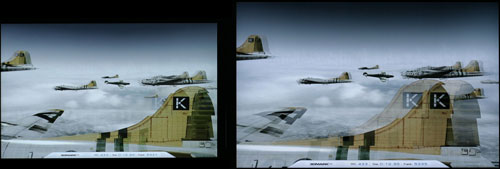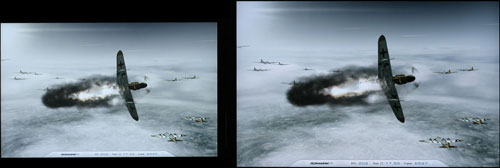HP LP3065: A new contender for the 30" throne
by Jarred Walton on March 22, 2007 7:00 AM EST- Posted in
- Displays
Response Times and Buffering
A topic that almost always comes up as a problem with LCDs is their slower response times relative to CRTs. There's no doubt that even the best LCDs still exhibit some slight pixel smearing, but the vast majority of users are okay with the level of performance we have available now. Image retention on your retinas also occurs to some extent, so even if you can completely eliminate the smearing effect at the display level you won't necessarily see a perfectly crisp transition.
Besides lag at the pixel level, there has also been discussion about a buffering lag that occurs within the LCD before the image is ever sent to the panel for output. This can be particularly noticeable on some HDTVs when connected to a computer, as HDTVs will often do a significant amount of image processing. Whether or not delays are caused by the internal circuitry or by the LCD crystal matrix taking a moment to align itself isn't really important; the end result is what matters, so a display that updates quicker is usually preferred, especially by gamers.
The Dell 2407WFP and Gateway FPD2485W LCDs advertise 16ms TrTf and 6ms GTG response times. The older Dell 2405FPW comes with a 12ms TrTf and 16ms GTG response time, which is sort of the opposite of what we see on most current displays. The 3007WFP lists 14ms TrTf and 11ms GTG, while the newer 3007WFPHC and the HP LP3065 rate 12ms TrTf and 8ms GTG response times. The Acer AL2216W comes with the fastest advertised response time of the displays we've tested so far, boasting a 5ms GTG response time, but it doesn't explicitly state a TrTf value. There are of course other LCDs that are rated even faster, and ratings aren't always accurate, so let's see how these displays compare in practical use.
We used the Dell 2407WFP as the "baseline" display, so it is on the left in all of the following images. We then started the first game demo from 3DMark03 and took numerous pictures, after which we selected several representing the best and worst case results that we could find. With all of the LCDs running a 60 Hz refresh rate, new frames are sent to the display every 0.017 seconds, so that's our granularity. Pay attention to the value of the Time field in the following screenshots, as that will show whether the two displays are showing the same frame or not. Results for the other displays are available at the following links:
Acer AL2216W #1 Acer AL2216W #2
Dell 2405FPW #1 Dell 2405FPW #2
Dell 3007WFP #1 Dell 3007WFP #2
Gateway FPD2485W #1
Despite having the highest rated response times, the Acer AL2216W display actually appears slightly worse than most of the other displays in terms of response times. Internal lag, on the other hand, puts the Acer display at the top of the list, followed closely by both 30" displays. Between the two 30" displays, the LP3065 appears to suffer from less internal lag, consistently running about one frame ahead of the 2407WFP. However, pixel lag appears to be slightly worse on the LP3065, and there are several images where we can see very clear transitions.
Having said that, we never noticed any problems with pixel smearing during subjective testing, and it was only when we resorted to using a camera that we could capture the slight differences between the displays. It's entirely possible that we're getting old so that our eyes aren't bothered by a difference of 0.017 seconds. We strongly feel that most people won't have a problem with the slight image smearing that occurs on these LCDs, but this is something that will vary by individual. If you know you are bothered by image smearing, try out a display in person to see if it's suitable for your needs.
A topic that almost always comes up as a problem with LCDs is their slower response times relative to CRTs. There's no doubt that even the best LCDs still exhibit some slight pixel smearing, but the vast majority of users are okay with the level of performance we have available now. Image retention on your retinas also occurs to some extent, so even if you can completely eliminate the smearing effect at the display level you won't necessarily see a perfectly crisp transition.
Besides lag at the pixel level, there has also been discussion about a buffering lag that occurs within the LCD before the image is ever sent to the panel for output. This can be particularly noticeable on some HDTVs when connected to a computer, as HDTVs will often do a significant amount of image processing. Whether or not delays are caused by the internal circuitry or by the LCD crystal matrix taking a moment to align itself isn't really important; the end result is what matters, so a display that updates quicker is usually preferred, especially by gamers.
The Dell 2407WFP and Gateway FPD2485W LCDs advertise 16ms TrTf and 6ms GTG response times. The older Dell 2405FPW comes with a 12ms TrTf and 16ms GTG response time, which is sort of the opposite of what we see on most current displays. The 3007WFP lists 14ms TrTf and 11ms GTG, while the newer 3007WFPHC and the HP LP3065 rate 12ms TrTf and 8ms GTG response times. The Acer AL2216W comes with the fastest advertised response time of the displays we've tested so far, boasting a 5ms GTG response time, but it doesn't explicitly state a TrTf value. There are of course other LCDs that are rated even faster, and ratings aren't always accurate, so let's see how these displays compare in practical use.
We used the Dell 2407WFP as the "baseline" display, so it is on the left in all of the following images. We then started the first game demo from 3DMark03 and took numerous pictures, after which we selected several representing the best and worst case results that we could find. With all of the LCDs running a 60 Hz refresh rate, new frames are sent to the display every 0.017 seconds, so that's our granularity. Pay attention to the value of the Time field in the following screenshots, as that will show whether the two displays are showing the same frame or not. Results for the other displays are available at the following links:
Acer AL2216W #1 Acer AL2216W #2
Dell 2405FPW #1 Dell 2405FPW #2
Dell 3007WFP #1 Dell 3007WFP #2
Gateway FPD2485W #1
 |
 |
 |
| HP LP3065 |
Despite having the highest rated response times, the Acer AL2216W display actually appears slightly worse than most of the other displays in terms of response times. Internal lag, on the other hand, puts the Acer display at the top of the list, followed closely by both 30" displays. Between the two 30" displays, the LP3065 appears to suffer from less internal lag, consistently running about one frame ahead of the 2407WFP. However, pixel lag appears to be slightly worse on the LP3065, and there are several images where we can see very clear transitions.
Having said that, we never noticed any problems with pixel smearing during subjective testing, and it was only when we resorted to using a camera that we could capture the slight differences between the displays. It's entirely possible that we're getting old so that our eyes aren't bothered by a difference of 0.017 seconds. We strongly feel that most people won't have a problem with the slight image smearing that occurs on these LCDs, but this is something that will vary by individual. If you know you are bothered by image smearing, try out a display in person to see if it's suitable for your needs.










44 Comments
View All Comments
gfisher - Sunday, July 26, 2009 - link
My HP machine has an NVIDIA 8500GT graphics card. I'm interested in buying a HP LP 3065 thirty inch monitor. Will the card drive the monitor at full speed?DaveJDSP - Sunday, December 30, 2007 - link
Jarred,I cannot possibly thank you enough for testing and posting photos of viewing angles. When doing critical photo/graphics work, it is essential that the top and bottom of the screen appear consistent from a fixed viewing point in the center of the screen. The larger the monitor, the more critical this becomes, as from a fixed point, the eyes scan over an arc of 10-20 degrees or greater.
Most monitors that I have seen at local stores have viewing angles that are totally unsatisfactory for critical work, even from a fixed eye point. And there are very few local stores that carry a sufficient selection of better and larger monitors, suitable for more critical work, so that the buyer can evaluate those monitors in person. Therefore, your complete and comprehensive reviews become even more critical.
Thank you again for your excellent reviews and for including such critical viewing angle information.
Dave
chakarov - Friday, March 23, 2007 - link
Contrast by specification shoud be 1000:1 but you measured it 585:1.It is interesting what to believe.
JarredWalton - Saturday, March 24, 2007 - link
As I explained in the Gateway FPD2485W review, contrast ratios, brightness levels, response times, and various other "spec sheet items" are often seriously exaggerated. While technically a higher contrast ratio is better, a 500:1 or higher real value is generally more than sufficient. There's also a possibility that at some specific setting the HP would come closer to 1000:1 - doubtful, given the results on the three tested settings (uncalibrated, calibrated, and print calibrated), but still possible.The basic issue is with backlight bleed - i.e. blacks that aren't actually black. In theory, any proper display would have an infinite contrast ratio, as black would be 0 and anything divided by zero is infinity/undefined. Some displays (the Acer, for example) achieve higher contrast ratios by having blacker blacks; others like the Gateway get them by having insanely bright whites. Anyway, more is not always better, as the color accuracy of the middle tones isn't represented by contrast ratio.
michal1980 - Thursday, March 22, 2007 - link
what about input lag vs a crt?crts should be the baseline since they seem to show close to 0 image lag.
lcd vs lcd is nice to, but if all lcds are off by a large number of frames from a crt, that will still suck
Souka - Thursday, March 22, 2007 - link
I feel a CRT vs LCD war thread starting..... ;)JarredWalton - Thursday, March 22, 2007 - link
LCDs are still slightly slower than CRTs, but we have abandoned the CRTs, or at least I have. I no longer have any for testing, and the last CRTs I purchased are now over two years old, the Samsung 997DF and the NEC FE991-SB. There hasn't been a new really high-end CRT released in upwards of five years, I don't think. Five or six year old 22" CRTs (with a 20" viewable diagonal) are better than the later 21/22" models in terms of features and performance. Then there's the whole geometry and signal adjustment that needs to be done on analog devices. Personally, I wouldn't even consider a CRT for my computer use anymore.Given that we have the 2407WFP for testing and it has been used already, we would prefer to continue with that trend. A baseline is just that: a reference point. Baseline doesn't have to be "best" - and obviously quite a few LCDs are better than the 2407WFP when it comes to input lag and response times. So far, however, we haven't seen more than a 1 frame (*maybe* two with the Acer AL2216W) difference in output. So the largest difference we've seen is currently less than 0.02 seconds.
Souka - Thursday, March 22, 2007 - link
Why not get a 30" Apple Cinema Display?AnnonymousCoward - Thursday, March 22, 2007 - link
Let's see, $2000 for the Apple versus $1274 for the Dell. If you like being charged up the @$$, then be my guest.Now, the Apple is competing with the LP3065 and 3007WFP-HC; those panels are superior and $300 cheaper retail. Not to mention I just bought the HC from Dell for $1430+tax. Why would you pay $570 more for a worse product?
dcalfine - Thursday, March 22, 2007 - link
YeaApple made the first 30" dual-link LCD for consumers and is often considered better than the Dell. It would be wise to consider it a contender.